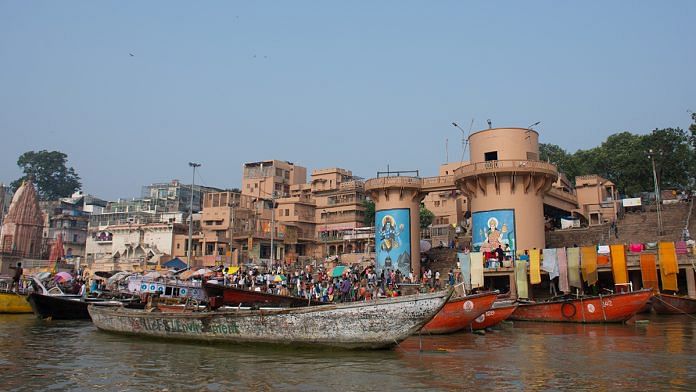New Delhi: The Modi government has stressed its continued focus on cleaning the Ganga in the last five years but latest official data shows that it could manage to complete just 28 per cent of sewerage infrastructure projects on the river until 31 May under the Namami Gange mission.
Under the programme with a 2020 deadline, sewerage infrastructure projects are coming up in eight states — Uttarakhand, Uttar Pradesh, Bihar, Jharkhand, West Bengal, Haryana Delhi and Himachal Pradesh — through which the 2,525-km river flows. Building sewerage infrastructure is one of the most crucial parts of the mission.
Currently, the 97 towns located on the main stem of the Ganga generate 2,953 million litres a day (MLD) of sewage. However, the available treatment capacity is only 1,794 MLD.
Of the 150 sewage treatment plants (STPs) that have been sanctioned so far at an estimated cost of Rs 26,169 crore, only 42 have been completed as on 31 May, according to data from the Ministry of Jal Shakti. Work is in progress in 60 others, while tendering process is on in another 48 projects, shows the data.
Once complete, the 150 STPs will have the capacity to treat 4,874 MLD of sewage.
Also read: Environment is the most under-reported disaster of Narendra Modi government
Running behind schedule
Data also shows that Bihar and Delhi are among the prominent laggards where not even one of the 28 and 11 projects sanctioned, respectively, have been completed.
While West Bengal has completed just three out of the 22 projects sanctioned, Uttar Pradesh, where the longest stretch (1,000 km) of the river flows, has completed just 13 of the 50 sanctioned STPs.
Uttarakhand, where 34 projects have been sanctioned, has completed the maximum number of projects at 22.
Of the eight states, Haryana is the only one that has completed the two projects that were sanctioned.
Officials in the Jal Shakti ministry, however, said that there has been no delay and the programme is on track.
“The whole process, from inviting tenders to awarding the project, takes times. We are hopeful of completing all the projects sanctioned under Namami Gange by 2020, the target set for cleaning the river,” said an official who did not want to be named.
Namami Gange challenges
After the Modi government came to power in 2014, cleaning the Ganga became one of its key focus areas.
It set up a special department — National Mission for Cleaning Ganga — under the water resources ministry and launched the flagship river cleaning programme Namami Gange in 2015 with a budget outlay of Rs 20,000 crore.
Despite the government’s thrust, however, cleaning the river continues to be a herculean task.
A December 2018 Central Pollution Control Board report even found that the water quality of the river was either clean or slightly polluted (of bathing standard or could support aquatic life) at only four of the 41 locations tested in the pre-monsoon stage and at only one of the 39 locations in the post monsoon phase.
Also read: Computers, the environment & lunar mining — how well Isaac Asimov predicted 2019
Govt push
A second ministry official said that though “Ganga” got dropped from the nomenclature when the ministry was renamed last month, cleaning the holy river continues to be high on the government agenda.
From Ministry of Water Resources, River Development and Ganga Rejuvenation, the name was changed to Ministry of Jal Shakti after the Modi government returned to power. The Ministry of Sanitation was also merged with it. It will deal with all water related issues.
The ministry has introduced several innovative measures to expedite cleaning up the river including remote sensing technologies.
Private players have been roped in by the government to set up STPs, operate and maintain them. In a first, the government also awarded 30 projects to private players under the Hybrid Annuity Model where the government pays 40 per cent of the capital cost during construction while the remaining capital investment cost, including operations and maintenance, is paid in quarterly installments by the government over a 15-year-period.
Besides building STPs, the ministry has also taken up riverfront development, including ghats and crematoria, in the eight states.
Also read: Why Delhi Jal Board is just not able to clean up the Yamuna mess



